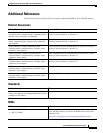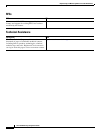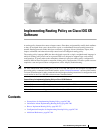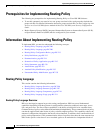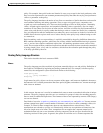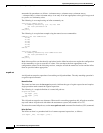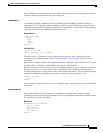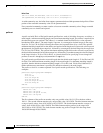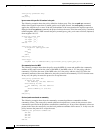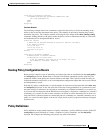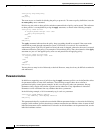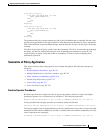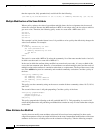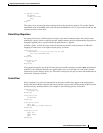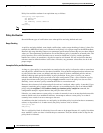
Implementing Routing Policy on Cisco IOS XR Software
Information About Implementing Routing Policy
RC-211
Cisco IOS XR Routing Configuration Guide
The following prefix-set consists entirely of invalid prefix match specifications:
prefix-set ILLEGAL-PREFIX-EXAMPLES
10.1.1.1 ge 16,
10.1.2.1 le 16,
10.1.3.0/24 le 23,
10.1.4.0/24 ge 33,
10.1.5.0/25 ge 29 le 28
end-set
Neither the minimum length nor maximum length is valid without a mask length. The maximum length
must be at least the mask length. For IPv4, the minimum length must be less than 32, the maximum
length of an IPv4 prefix. For IPv6, the minimum length must be less than 128, the maximum length of
an IPv6 prefix. The maximum length must be equal to or greater than the minimum length.
Routing Policy Language Components
Four main components in the routing policy language are involved in defining, modifying, and using
policies: the configuration front end, policy repository, execution engine, and policy clients themselves.
The configuration front end (CLI) is the mechanism to define and modify policies. This configuration is
then stored on the router using the normal storage means and can be displayed using the normal
configuration show commands.
The second component of the policy infrastructure, the policy repository, has several responsibilities.
First, it compiles the user-entered configuration into a form that the execution engine can understand.
Second, it performs much of the verification of policies; and it ensures that defined policies can actually
be executed properly. Third, it tracks which attach points are using which policies so that when policies
are modified the appropriate clients are properly updated with the new policies relevant to them.
The third component is the execution engine. This component is the piece that actually runs policies as
the clients request. The process can be thought of as receiving a route from one of the policy clients and
then executing the actual policy against the specific route data.
The fourth component is the policy clients (the routing protocols). This component calls the execution
engine at the appropriate times to have a given policy be applied to a given route, and then perform some
number of actions. These actions may include deleting the route if policy indicated that it should be
dropped, passing along the route to the protocol decision tree as a candidate for the best route, or
advertising a policy modified route to a neighbor or peer as appropriate.
Routing Policy Language Usage
This section provides basic routing policy language usage examples. See the “How to Implement
Routing Policy” section on page RC-237 for detailed information on how to implement routing policy
language.
The pass policy
The following example shows how the policy accepts all presented routes without modifying the routes.
route-policy quickstart-pass
pass
end-policy
The drop everything policy
The following example shows how the policy explicitly rejects all routes presented to it. This type of
policy is used to ignoring everything coming from a misbehaving peer.



